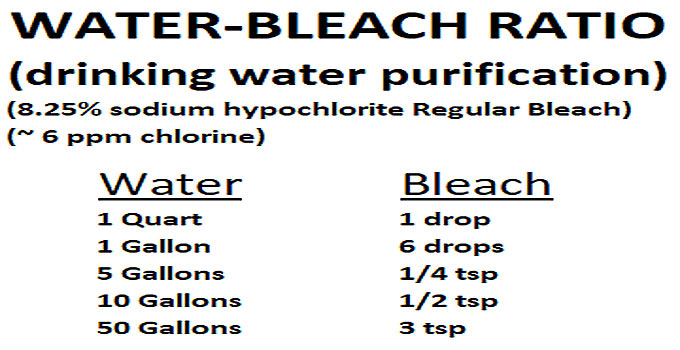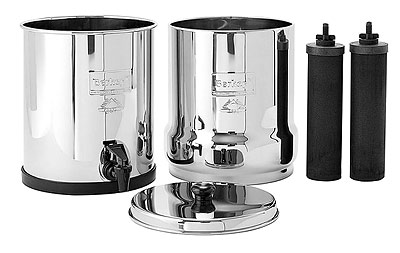Bleach – Water Ratio For Drinking Water Purification

If your water source is uncertain, you should treat it first before drinking it.
One way to treat water for drinking is to add a small amount of Regular Bleach (chlorine). Here’s how much regular bleach to add:
(details below)
One best way to purify water for drinking is to boil it for 1 minute.
[ Read: How Long to Boil Drinking Water until Safe or Disinfected ]
Once the water has reached a rolling boil, it has become safe to drink.
Note that if the water source had been contaminated with chemicals, boiling it or otherwise treating it will NOT assure that the chemical is removed.
Know your water source as best you can.
Another way to purify water is to use a small amount of Regular liquid bleach.
Use Regular household bleach, with the only ‘active’ ingredient ‘sodium hypochlorite’.
UPDATE: For many years Regular bleach contained a concentration of 5.25% sodium hypochlorite. Newer ‘Regular’ liquid bleach (which has been available for several years) now contains a concentration of 8.25% sodium hypochlorite (about 57% more than the original bleach formula).
(I have listed both amounts below for your reference.)
Having recently determined how much bleach to add to a 50-gallon water tank to purify it for safe drinking, I’ve put together the following charts for your reference.
One old ‘saying’ – a way to remember for small quantities:
“You must be 21 to drink”
2 drops bleach per 1 quart water
Mix the following amount of bleach with water, and wait 30 minutes for it to work. The water should have just a ‘hint’ of chlorine smell.
Water – Bleach Ratio For Purification
(Bleach containing 5.25% Sodium Hypochlorite)
numbers are ’rounded’
This will initially produce ~ 5 ppm chlorine
1 Quart water, 2 drops bleach
1 Gallon water, 8 drops bleach
5 Gallons water, 1/2 teaspoon bleach
10 Gallons water, 3/4 teaspoon bleach
50 Gallons water, 4 teaspoons bleach
Water – Bleach Ratio For Purification
(Bleach containing 8.25% Sodium Hypochlorite)
numbers are ’rounded’
This will initially produce ~ 5 ppm chlorine
1 Quart water, 1 drop bleach (1.3 rounded)
1 Gallon water, 5 drops bleach
5 Gallons water, 1/4 teaspoon bleach
10 Gallons water, 1/2 teaspoon bleach
50 Gallons water, 2-1/2 teaspoons bleach
Read more: Smallest Berkey Countertop Water Filter – Specs
NOTES:
The initial chlorine level (ppm) will drop when interacting with water and organic contaminants (it’s doing it’s job). This may occur slowly or precipitously.
If the water is cloudy, and if you still cannot smell any chlorine in the water after having let it sit for 30 minutes (there should be a hint of chlorine smell), the CDC (Centers for Disease Control) advises that you consider a 2nd round of treatment.
According to the EPA, the maximum recommended ppm (parts per million) of chlorine bleach in drinking water is apparently 4 ppm.
Generally speaking, water that has a chlorine level of 4 ppm would smell very strong of chlorine, whereas a ‘hint’ of smell indicates a level well below that. A chlorine test kit is the only true way to know for sure.
Bleach will lose its potency (fairly quickly) over time. Generally, 6 months to a year after its expiration date may result in half strength.
[ Read: How Much Bleach for Disinfecting Surfaces (Food & Non-food Surfaces) ]
[ Read: How Much Chlorine Bleach To Add In My Water Storage ]
